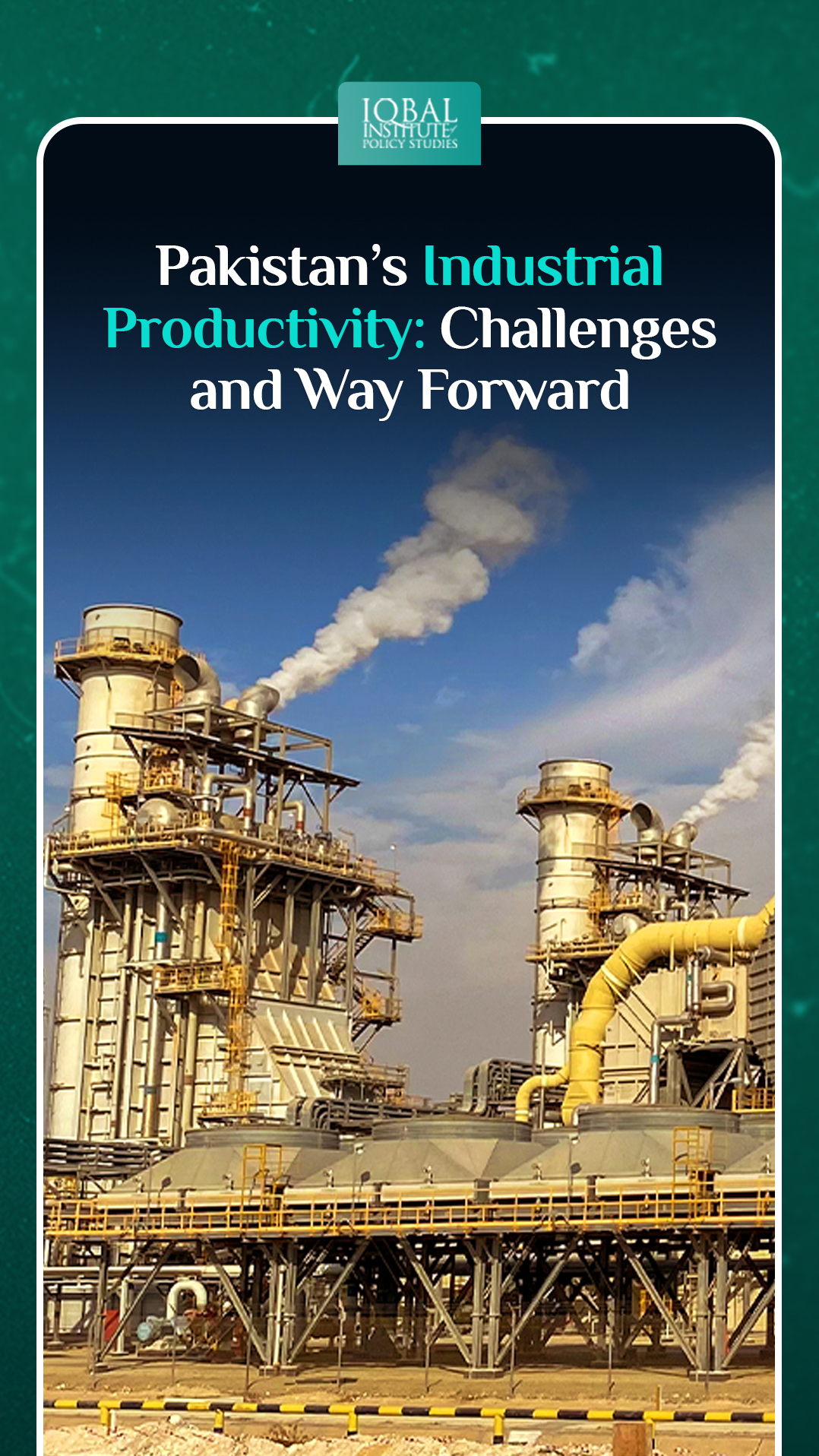Productivity is substantial because it is the key factor that drives economic growth and income levels. The income level is vital in defining human welfare. A prosperous industrial sector increases the national income of an economy and promotes people’s living standards. Thus, the special characteristics that define the importance of the industrial sector are trade integration and globalisation, economies of scale, and rapid technological changes. Since the industrial revolution, it was generally accepted that ‘no country can become a major economic power without becoming an industrial power’ (Su & Yao, 2016).
However, in Pakistan productivity of the industrial sector is contracting. It is because the firms are experiencing reduced efficiency, and the resources are allocated optimally. The poor performance of the industrial sector is also affecting the economy’s overall growth.
Snap Shot of the Industrial Sector of Pakistan
As per the official survey, the industrial sector contributed 12.4% to the GDP in 2022. It has been divided into three tiers, i.e., Large Scale Manufacturing (LSM), Small Scale Manufacturing (SSM), and Slaughtering. LSM dominates the overall manufacturing sector as it contributes 9.2% to the GDP and accounts for 74.3% of the sectoral share, SSM contributes 2% of the GDP, and its sectoral share is 15.9%. Similarly, slaughtering accounts for 1.2% of the GDP and 9.7% of the sectoral share (GoP, 2022).
No country in the world is self-sufficient to produce all the products. Every country has to trade certain goods to meet the demand. Pakistan has the fifth largest trade market in the world after China, India, the US, and Indonesia, but the country was ranked 42nd in terms of nominal GDP. The exports of India and Indonesia are $ 322 and $ 183 billion, and exports in Pakistan were US$ 25.3 billion in 2020, surpassing the set target, i.e., US$ 22.7 billion (Zulkifa,2020).
Firms’ Productivity Dynamics
The firm-level data shows a gloomy picture of productivity over the past decades. It was estimated that there is a minute improvement in the State Owned Enterprise (SEO) of the least productive firms. Additionally, there is no remarkable improvement in average productivity.
The firm’s productivity was reduced by 23% in 2020 compared to 2019 because of COVID-19.
In Pakistan, older firms are making less profit and becoming futile. The 40 years older firms are making a profit equivalent to less than a 10-year-old firm. Whereas in India, older firms make 30 to 40% more profit than younger ones.
The larger firms in Pakistan are making more profit than the smaller ones. A positive relationship exists between size, measured by firms’ sales and productivity.
The managerial practice has been considered one of the main indicators of firm-level productivity. In Pakistan, industries are adopting new technologies due to poor management practices.
Productivity and innovation are correlated. Firms with low productivity have a low investment in innovation, which increases as one moves up the productivity ladder (World Bank, 2022).
Major Challenges
Frequent Short Fall of Power
Energy crises in Pakistan are due to insufficient power capacity, outdated power plants, and deteriorating transmission and distributing infrastructure with limited financial capabilities (Raza et al., 2022). The frequent shortfall of power increases the cost of production. Punjab consumes 64% of the nationwide electricity produced, meaning power outages will affect it more than other provinces. Only small-scale manufacturing has to bear a power outage loss of Rs 21 billion (Abbas, 2016).
Administrative Challenges
The incompetent administrative process has increased the transaction cost for businessmen. Such as, initiating a business requires 16 days, and its time cost will be Rs 4,190; a construction permit will take 23 days, and investors would have to pay Rs 62,015,952 for days required to enforce contracts, and businessmen have to pay Rs 246,109, etc. Setting up business operations is time-consuming because investors must coordinate with several federal and governmental organisations. Pakistan has a complex Tax system, and multiple tax procedures have created several challenges for investors. The refund procedures are composed and overly regulated. Pakistan has 47 different types of taxes, whereas India has only 13, and Hong Kong has only one (Hera et al., 2017).
Low productivity of Industries
The low productivity of industrial units has increased the cost of production. There are two reasons behind it. Unsophisticated manufacturing techniques: Pakistan was ranked 93rd in the Economic Complexity Index (ECI) in 2019, and in 1970 the country was in 52nd place. It was found under the analysis of ECI that the economic structure of Pakistan was more complex at that time, had a diversified production structure, and the products Pakistan was exporting were not excessively available in countries such as Thailand, Brazil, Indonesia, and Turkey (Ishtiaq & Chaudhry, 2020). Secondly, the unskilled labour force required to gear up the industrialisation process needs skilled and efficient labour. The International Labour Organization (ILO) has measured the labour productivity (output per person) of different countries and stated that China’s labour productivity has increased up to 388%, India’s by 177%, Bangladesh’s by 109%, and Pakistan’s labour productivity is only 32%. There are several reasons for low labour productivity, such as no or low-skilled workers, increased technology adoption, and a mismatch of skills (Sarwar, 2020).
Financial Access to Industries
Less availability of finance hinders investment in the industrial sector.
57% of the firms did not require loans for investment in Pakistan which is the second-highest percentage in the South Asian countries.
In Pakistan, only 8% of the firms are approaching banks for investment purposes, and its percentage is highest in Srilanka, i.e., 44%.
As per the Survey, 13% of people identified that access to finance is a major constraint, whereas 15% in India and 23% in Bangladesh.
Accessing a loan is a major constraint for SMEs because commercial banks are unwilling to provide loans to small enterprises because they perceive it as too risky (Karandaaz, 2020)
Lack of Innovation
The transition of companies from smaller to large size is dependent upon technological upgradation. The industries will generate employment for the young labour force in this process. The world bank report identifies that innovation in high-growth firms will generate 50% of new jobs. If companies incorporate innovation, the export will also increase an advantage for local firms because they become more competitive. In the GlobalIn Global Innovation Index, Pakistan was ranked 87th among 132 economies. This shows that the country is still lacking in innovation and technology adoption.
Way Forward
Reorient the credit facilities from the export Finance Scheme into long-term financing for investment expansion and innovation;
To improve the performance of SEO, the government need to comply with corporate governance rules and privatise the loss-making SEO;
Improve the innovation ecosystem by enforcing the protection of trademarks on export products.
Government should regularise private-public partnerships and investment in improving management services;
Strengthen and develop skilled human resources in order to increase productivity and efficiency;
Government should make efforts to provide uninterrupted electricity;
All the stakeholders should increase and sustain the supply of quality raw materials;
Ensure a level playing field for domestic and foreign players across sectors;
Government should improve the business-enabling environment by reducing entry barriers.
Conclusion
Industrial productivity is imperative for the growth of the economy. In Pakistan, the industrial sector is facing various challenges, such as power shortages, administrative flaws, low productivity of industries, lack of innovation etc. The government has to improve the infrastructure of the industries, regularise private and public partnerships, provide a skilled workforce and provide uninterrupted electricity. To become a prosperous country, the government has to revamp the industrial sector.
References
Hera et al. (2017). Impact of Technical Non-tariff Measures on Pakistan Exports. PSDE.
Ishtiaq, N., & Chaudhry, A. (2020). Productive Capabilities and Economic Development: A Case for Industrial Diversification in Pakistan. PSDE.
Karandaaz. (2020). Businesses in Pakistan and Their Access to Financial Services. Retrieved from Karandaz.com.pk: https://karandaaz.com.pk/blog/businesses-pakistan-access-financial-services/
Sarwar, N. (2020). Pakistan’s low productivity and the way out. Retrieved from Tribune: https://tribune.com.pk/story/2258770/pakistans-low-productivity-and-the-way-out
World Bank. (2022). From Swimming in Sand to High and Sustainable Growth. World Bank Group.
Zulkifal, S. (2020). Industrial Sector of Pakistan: An Analysis of Its Export. Retrieved from Strafasia: https://strafasia.com/industrial-sector-of-pakistan-an-analysis-of-its-exports/



Leave a Reply